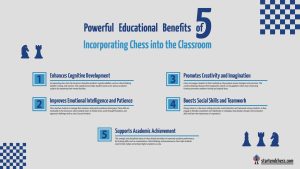5 Powerful Educational Benefits of Incorporating Chess into the Classroom
Incorporating chess into the classroom is a transformative approach that goes beyond traditional learning methods. As educators seek innovative ways to engage students and enhance their cognitive abilities, chess emerges as a powerful educational tool. This ancient game is not just about mastering the board; it offers students a unique opportunity to develop critical thinking, problem-solving skills, and emotional intelligence. By integrating chess into the curriculum, teachers can create a dynamic learning environment that stimulates the mind, fosters creativity, and encourages social interaction.
The benefits of bringing chess into the classroom are profound and far-reaching. Students who engage with chess regularly not only improve their academic performance but also gain valuable life skills such as patience, resilience, and strategic thinking. As more schools recognize the educational value of chess, it’s becoming an essential part of the modern classroom, offering a fun and challenging way to enrich students’ educational journeys.
- How does incorporating chess into the classroom benefit students?Incorporating chess into the classroom enhances cognitive skills such as problem-solving, memory, and critical thinking. It also promotes emotional intelligence, creativity, and social interaction, leading to improved academic performance and personal development.
- At what age can students start learning chess in the classroom?Students as young as 5 or 6 years old can start learning chess. The game can be introduced in a simplified manner at first, gradually increasing in complexity as students develop their understanding and skills.
- Do students need prior knowledge of chess to benefit from it in the classroom?No prior knowledge of chess is required. Chess can be introduced to students with no experience, and they can learn the rules and strategies over time, gradually reaping the educational benefits as they progress.

-
Enhances Cognitive Development
Introducing chess into the classroom can be associated with a number of important advantages, especially in the area of enhancing cognitive development. Chess is a game that requires much concentration, strategy, and problem-solving skills. Every move requires anticipation of opponents’ actions or steps and several moves ahead, hence sharpening critical thinking and decision-making skills—the core thinking development abilities needed for academic success.
Key Cognitive Skills Developed Through Chess:
- Problem-Solving: It teaches them how to identify problems and find out their effective solutions, hence transferable to subjects like mathematics or science.
- Memory: It enhances both short-term and long-term memory through knowing the position of pieces, record of earlier moves, and strategies.
- Attention and Focus: It improves the student’s attention span since chess requires someone to be focused for a long period of time.
- Analytical Thinking: Through them, students acquire the skills to weigh different situations and possible outcomes and develop their analytical and critical thinking.
It has been documented that students who play chess regularly improve in test scores, particularly in mathematics and reading comprehension, for the game cultivates both logical and verbal skills.
-
Improves Emotional Intelligence and Patience
Playing chess is more than just a mental exercise; it also sparks excellent effects on emotional intelligence. Students learn how to manage their emotions when a game is lost or when they make a wrong move, which fosters frustration. The game calls for one to remain calm, patient, and persistent, and it is important in the process of emotional development.
Emotional Benefits of Chess:
- Patience: It teaches the student that quite often, success takes time and thought, encouraging a patient and deliberate approach to what one does.
- Resilience: Losing a game helps the student learn to cope with failure and encourages them to try again, building resilience.
- Self-Discipline: It helps chess players to think before acting. This links with the inbuilt aspect of self-control, which expands to influence disciplined behavior within and outside a classroom.
- Empathy: This kind of opponent perspective understanding is the essence of chess and may be carried over to enhance empathy and social understanding in real-life encounters.
Chess has been integrated into the classroom as a means of experiencing emotions in a safe environment and for the management of those emotions, therefore enabling better emotional regulation and interpersonal skills.

-
Promotes Creativity and Imagination
It thus follows that if chess is essentially a game of logic and one in which one develops a strategy, it will encourage and develop creativity and an imagination. This heightened creativity and imagination will culminate from the attractiveness to unlimited possibilities that the game offers. Its logic and creativity further build a types of problem-solving corpus for students.
How Chess Enhances Creativity:
- Strategic Innovation: This also enhances creative thinking since students are encouraged to think of their own strategies.
- Imaginative Play: It helps develop skills in visualizing moves with their results and stirs the imagination to think creatively.
- Art of Planning: Chess means the building of long plans, often complicated and multi-step, whose realization involves creativity and originality.
Creativity is one of life’s most treasured resources, and chess provides an interesting way for pupils to build on this attribute in the school setting.
-
Boosts Social Skills and Teamwork
Chess can be conceived of as an individual game, but it can also be a social activity in its working in a team and its collaboration. Played in pairs, teams, or the setting of a club, chess offers a lot of opportunities for students to socialize and build those skills.
Social Benefits of Chess:
- Communication: Discussions on the strategies, moves and the outcomes of the game motivate the children to communicate effectively amongst peers.
- Teamwork: It helps the students learn to work for a common cause whenever chess is played in team formats.
- Respect and Sportsmanship: It also teaches respect toward opponents and how to show good sportsmanship.
- Conflict Resolution: Chess will teach the students how to handle disagreements with their opponent on or off the board.
Chess in the classroom can be one of the ways to enable the growth of social skills in students, which are very important for the general lives of students.

-
Supports Academic Achievement
The benefits of chess actually can help in the sphere of academic performance, so it should be taught in schools. Chess has given advantages to students regarding their academic achievements on subjects such as math, reading, and science. This is applied directly from the skills formulated through chess, hence making a student more competent and confident in learning.
Academic Benefits of Chess:
- Mathematics: Chess improves your problem-solving skills, logical thinking, and spatial awareness. These are all combined elements of what one needs to be good at math.
- Reading Comprehension: The game enhances memory and analysis—key components of reading comprehension.
- Science: Chess, as it involves formulations of hypotheses, testing, and revision of strategies in the light of results, instigates scientific thinking.
By incorporating chess into the classroom, therefore, a teacher is providing his students with an activity that is at one and the same time enriching and headache-inducing, yet able to help students improve in all areas of their studies.

Conclusion
Incorporating chess into the classroom offers a world of benefits that extend far beyond the game’s 64 squares. It’s not just about learning how to play; it’s about equipping students with essential life skills such as critical thinking, emotional resilience, and creativity. Chess transforms the classroom into a dynamic space where students are challenged to think deeply, plan strategically, and learn from every move they make. This powerful tool not only enhances cognitive abilities but also nurtures personal growth, making it an invaluable addition to any educational setting.
By bringing chess into the curriculum, educators can ignite a passion for learning that resonates across all subjects. Whether it’s improving math skills, boosting reading comprehension, or fostering teamwork, chess has the unique ability to engage students in a way that traditional methods often can’t. It’s more than a game; it’s a pathway to academic success and lifelong skills that students will carry with them far beyond their school years. Embracing chess in the classroom is a move that can set students on a winning path, both in education and in life.
We’ve prepared a podcast to accompany this article, offering the same insights in an audio format. If you enjoy listening, give it a play:
References:
- Burgoyne, A. P., et al. (2016). “The Effect of Chess Instruction on the Mathematical Problem Solving of Elementary School Students.” Journal of Educational Psychology, 108(1), 21-35.
- Sala, P., Gobet, F., Trinchero, R., & Ventura, P. (2017). “Chess Instruction and Academic Achievement: A Systematic Review and Meta-Analysis.” Educational Psychology Review, 29(3), 393-406.
- Wang, L., & O’Connell, P. (2019). “Chess in the Classroom: The Effect of Chess on Student Learning Outcomes.” Journal of Education and Learning, 8(3), 58-68.
- Chabris, C. F., & Glickman, M. (2006). “Why We Should Teach Chess to Kids: A Review of the Research.” American Journal of Play, 1(1), 95-104.
- Lobo, P., & Gonsalves, S. (2021). “The Impact of Chess on Social and Emotional Skills Development in Students.” International Journal of Educational Research, 107, 101726.
- Rios, A. L., & Palacios, R. (2020). “Fostering Emotional Intelligence Through Chess.” Education and Information Technologies, 25(5), 3883-3898.
- Steenberg, C., & Lindström, B. (2018). “The Role of Chess in Education: Benefits Beyond the Board.” Educational Studies, 44(2), 164-178.



0 Comments